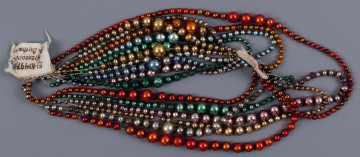
“Tube” corals
1900 — 1930
National Museum in Lublin
Part of the collection: Folk craft of the Lublin Region (19th/20th c.)
A scapular from Piotrków near Lublin from the end of the 19th century is two-piece and is square-shaped with sides of 5 cm. Scapulars of this type were made of woollen fabric or cloth, on which cloth with pictures, embroideries or woodcuts depicting religious symbols was glued or sewn. Sometimes holy pictures, medallions or crosses were inserted between the layers of fabric. One part rested on the chest, the other on the back. In the Krzczonów and Zamość areas, women also wore them on their clothes together with beads or hidden under their shirts. Some people still wear scapulars of this type.
This scapular is made of two squares connected with two white ribbons. The squares are of black fabric and their edges are trimmed with floral fabric. In the centre of each, there is a red fabric heart trimmed with a knitted stitch. One of them is embroidered with the same stitch with the IHS symbol with a cross over the letter H, the so-called Christogram, which was an abbreviation of various Christological terms or titles. However, it is most often treated as a simple Latin transcription of the abbreviated Greek version of the name Jesus. The origins of usung the acronym probably date back to the 3rd century CE. It was used as a secret designation of the graves of Christians. In the 15th century, Christians wrote it on the doors of their homes. On the second square, above the heart, are embroidered the letters PA, which may be the initials of the owner. The remaining space is filled with embroidered flowers in purple, cream and green. The scapular was also decorated with sequins, two of which have survived, and there probably were more of them symmetrically distributed.
Scapulars worn in the past and today every day by believers are a sign of devotion to the Mother of God and an expression of piety. In the past, they were an indispensable part of a bride's wedding dress in the Krzczonów region. They were supposed to protect their owner who took part in the rite of passage from dangers threatening her, especially in the marginal phase, when she did not belong to the group of maidens or married women.
Author / creator
Dimensions
cały obiekt: height: 6,5 cm, width: 6,5 cm
Object type
scapular
Technique
own
Material
cardboard, muline yarn, band
Creation time / dating
Creation / finding place
Owner
The National Museum in Lublin
Identification number
Location / status